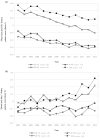Thirteen-Year Trends in Dietary Patterns among Japanese Adults in the National Health and Nutrition Survey 2003⁻2015: Continuous Westernization of the Japanese Diet
- PMID: 30061492
- PMCID: PMC6115850
- DOI: 10.3390/nu10080994
Thirteen-Year Trends in Dietary Patterns among Japanese Adults in the National Health and Nutrition Survey 2003⁻2015: Continuous Westernization of the Japanese Diet
Abstract
We examined 13-year trends in dietary patterns, using data from the National Health and Nutrition Survey, Japan 2003⁻2015. In repeated, independent cross-sectional studies, dietary intake was assessed with a one-day weighed dietary record in 88,527 Japanese adults aged ≥20 years. Using principal component analysis based on the daily consumption of 31 food groups, we identified three dietary patterns, the "plant food and fish", "bread and dairy", and "animal food and oil" patterns. In the whole sample, the "plant food and fish" pattern score decreased while the "bread and dairy" and "animal food and oil" pattern scores increased. The decreasing trends in the "plant food and fish" pattern were observed in all subgroups considered. The increasing trends in the "bread and dairy" pattern were similar across sexes and by current smoking status. However, in terms of age, occupation, and weight status, the increasing trends were only evident in particular subgroups (i.e., age 50⁻64 and ≥65 years; security/transportation/labor occupation and nonworker; and normal weight and overweight participants). For the "animal food and oil" pattern, the increasing trends were observed in all subgroups, except for the youngest age group (20⁻34 years old). This study suggests continuous Westernization of the Japanese diet.
Keywords: dietary patterns; food consumption patterns; national survey; principal component analysis; trend analysis.
Conflict of interest statement
The authors declare no conflicts of interest.
Figures




References
MeSH terms
LinkOut - more resources
Full Text Sources
Other Literature Sources
Molecular Biology Databases

